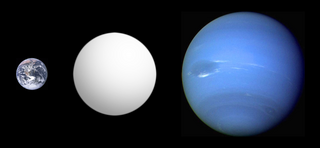
Gliese 436 is a red dwarf located 31.9 light-years away in the zodiac constellation of Leo. It has an apparent visual magnitude of 10.67, which is much too faint to be seen with the naked eye. However, it can be viewed with even a modest telescope of 2.4 in (6 cm) aperture. In 2004, the existence of an extrasolar planet, Gliese 436 b, was verified as orbiting the star. This planet was later discovered to transit its host star.

55 Cancri e is an exoplanet in the orbit of its Sun-like host star 55 Cancri A. The mass of the exoplanet is about 8.63 Earth masses and its diameter is about twice that of the Earth, thus making it the first super-Earth discovered around a main sequence star, predating Gliese 876 d by a year. It takes fewer than 18 hours to complete an orbit and is the innermost-known planet in its planetary system. 55 Cancri e was discovered on 30 August 2004. However, until the 2010 observations and recalculations, this planet had been thought to take about 2.8 days to orbit the star. In October 2012, it was announced that 55 Cancri e could be a carbon planet.
Mu Arae c, also known as HD 160691 c, formally named Dulcinea, is an extrasolar planet orbiting the star Mu Arae of the constellation Ara. It was the first 'hot Neptune' to be discovered.

Gliese 436 b is a Neptune-sized exoplanet orbiting the red dwarf Gliese 436. It was the first hot Neptune discovered with certainty and was among the smallest-known transiting planets in mass and radius, until the much smaller Kepler exoplanet discoveries began circa 2010.

GJ 1214 b is an exoplanet that orbits the star GJ 1214, and was discovered in December 2009. Its parent star is 48 light-years from the Sun, in the constellation Ophiuchus. As of 2017, GJ 1214 b is the most likely known candidate for being an ocean planet. For that reason, scientists often call the planet a "waterworld".

GJ 1214 is a dim M4.5 red dwarf star in the constellation Ophiuchus with an apparent magnitude of 14.7. It is located at a distance of 47.8 light-years from Earth. GJ 1214 hosts one known exoplanet.

WASP-121b, formally named Tylos, is an exoplanet orbiting the star WASP-121. WASP-121b is the first exoplanet found to contain water in an extrasolar planetary stratosphere. WASP-121b is in the constellation Puppis, and is about 858 light-years from Earth.
GJ 9827 is a star in the constellation of Pisces. It is a K-type main-sequence star with an apparent magnitude of 10.250. It is 97 light-years away, based on parallax.
HAT-P-26 is a K-type main-sequence star about 466 light-years away. A survey in 2015 did not find any stellar companions in orbit around it, although a red dwarf companion with a temperature 4000+100
−350 K is suspected on wide orbit.
HAT-P-21 is a G-type main-sequence star about 910 light-years away. The star has amount of metals similar to solar abundance. The survey in 2015 has failed to detect any stellar companions. The star is rotating rapidly, being spun up by the tides of giant planet on close orbit.
GJ 3470 is a red dwarf star located in the constellation of Cancer, 96 light-years away from Earth. With a faint apparent magnitude of 12.3, it is not visible to the naked eye. It hosts one known exoplanet.
WASP-69, also named Wouri, is a K-type main-sequence star 164 light-years away. Its surface temperature is 4782±15 K. WASP-69 is slightly enriched in heavy elements compared to the Sun, with a metallicity Fe/H index of 0.10±0.01, and is much younger than the Sun at 2 billion years. The data regarding starspot activity of WASP-69 are inconclusive, but spot coverage of the photosphere may be very high.
LTT 9779 is a G-type main-sequence star located 264 light-years away from the Solar System in the constellation of Sculptor. The star is about 95% the radius and about the same mass as the Sun, but younger than the Sun at 1.7 billion years old, hence its lower luminosity. It has a temperature of 5,443 K and a rotation period of 45 days. LTT 9779 is orbited by one known exoplanet.













